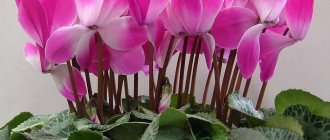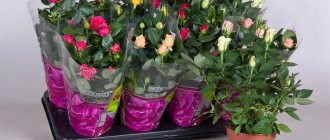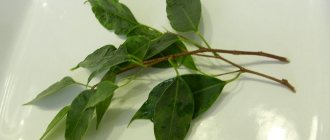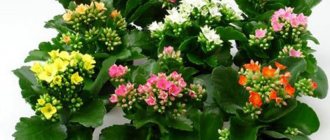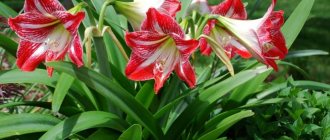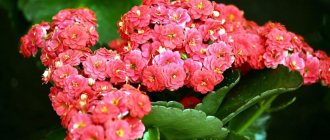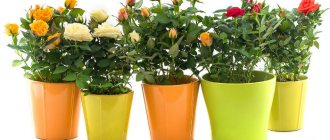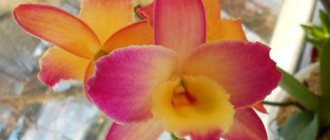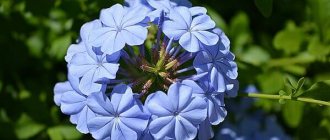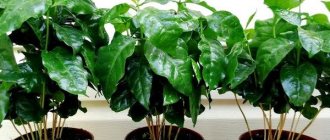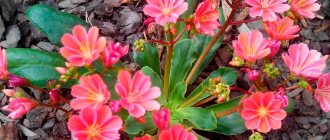Kalanchoe flower: types and description
Caring for Kalanchoe at home is not difficult. Here are the most popular perennial species:
- Kalanchoe Degremona. In apartment conditions, it reaches a length of up to 70 cm and has monochromatic jagged sheets. The juice of the plant has healing properties in the treatment of runny nose, sinusitis, etc. The variety is unpretentious, quickly produces babies, takes root and even blooms with miniature bells;
- Kalanchoe pinnate is another medicinal variety. The leaves are round and uniformly green. Outwardly they resemble feathers, hence the name;
- Kalanchoe tubiflora or tubiflora. Forms a single stem up to a meter long, leaves and flowers are twisted into a tube;
- Kalanchoe Magnini is an ampelous flowering bryophyllum. Flowers may be orange or red;
Kalanchoe Degremona
- Kalanchoe Blossfeld. The most popular variety, most often found in stores with the inscription “Kalanchoe mix” or “Kalandiva”. The latest series was bred by breeders. The flower has 32 petals, so it looks like miniature roses. With proper care, the plant blooms continuously for up to four months. Kalanchoe Kalandiva can have red, pink, orange and white flowers. The bushes reach a length of up to 50 cm; there are also more compact varieties (Rosalina). There is also a Grandiva series with larger inflorescences;
- Kalanchoe Fedchenko. The succulent reaches up to 60 cm in length, the leaves are fleshy, dark green with a pink border. In intense sunlight, the shade spreads across the entire leaf blade;
- Tomentosa. The species has a stem covered with hairs. This ornamental Kalanchoe is often used for outdoor landscaping;
- Kalanchoe Laciniata. A common indoor type, popular name is “deer antlers”. The leaves are elongated with a fairly dense surface.
Kalanchoe pinnate
This is not the entire list, because, as mentioned above, the family has more than 200 species.
Kalanchoe laciniata
Description of the plant
Kalanchoe belongs to the group of succulents. The flower does not grow in the wild, as it was bred by breeders. Other types of plants can be seen in nature on almost all continents of the globe.
Kalandiva is a particularly decorative flower, which is noted for its long and abundant flowering. This is a compact bush that has fairly thick stems. The flower is characterized by the presence of neat fleshy leaves, which are not deprived of smoothness or velvety. The height of the bush does not exceed 30 cm.
The plant is distinguished by the presence of short peduncles on which inflorescences of small double flowers are located. They are distinguished by a variety of colors.
The flowers of the plant can be pink, red, salmon, yellow.
Flowering Kalanchoe is a short-day crop. The plant will bloom only if the light regime is strictly observed. The culture is characterized by abundant flowering, which can be observed for 6 months. In most cases, Kalanchoe blooms in mid-winter.
Important! From mid-summer, a dormant period begins, which is characterized by mild expression. That is why Kalanchoe kalandiva does not need special care at this time.
Kalanchoe calandiva is a rather attractive flower that can decorate the design of any room with original blooms.
Kalanchoe Kalandiva: home care
Aeonium: home care and main species of the family
Decorative varieties of Kalanchoe are perfect for landscaping at home. In addition to beautiful flowering, the plant brings benefits - it cleanses the air of harmful toxins. However, many do not know the intricacies of flower care. The result is that the bush does not bloom and stretches out. Caring for Kalanchoe is as follows:
- The temperature of the content is not important unless we are talking about extreme drops to sub-zero levels. The plant thrives in both heat and temperatures down to 0 °C. Some people keep the flower pot outside from May to September;
- Kalanchoe prefers fairly bright lighting. It is best to choose the sunniest places; like all succulents, this species is hardy even in the southern regions of the country. Without normal lighting, bud formation is impossible;
- Watering is carried out depending on weather conditions. In the hot season, it is best to increase the amount of water; water the plant 2 times a week. In late autumn and winter, if there is no additional lighting, the frequency of watering should be reduced to 2 times a month;
- As for humidity, if the air is too dry, yellow dry spots or an invasion of spider mites can be observed on the leaves. It is useless to spray the sheets, since due to the smooth surface the water will simply roll down. It is best to place a jug of water next to it or put wet expanded clay in a tray. It is worth noting that such cases are quite rare, since Kalanchoe does not have special requirements for air humidity;
- It is best to purchase soil for succulents. For greater looseness, sand is added, and for nutritional value, a small amount of humus is added. Fertilizers should be applied no more often than once every three months. The plant immediately reacts to excess feeding: you can see yellowing and wrinkling of the leaves.
Conclusion
Kalanchoe is a simple and easy-to-care flower. In skillful hands and with proper care, it can become a real decoration. Even any gardener can cope with the flower, and the fact that the plant reproduces easily and is not afraid of pruning and replanting will help a novice florist not be afraid to make a mistake.
Kalanchoe fits into any interior and looks beautiful almost anywhere in the house or apartment.
How does Kalanchoe reproduce?
Succulents: home care and main types of the family
The plant can be propagated in two ways - seeds and cuttings. The first method takes longer, but the resulting specimen has greater endurance. Good for rare species. Seed germination is carried out as follows:
- Loose soil is prepared.
- A small layer of earth is placed in small containers.
- Seeds are placed on top.
- Sprinkle with a thin layer of soil.
- Next, the soil with the seeds is sprayed and covered with film. It is best to choose a sufficiently lit place without drafts.
Note! It is necessary to monitor humidity: the soil should be slightly moist, but not wet. If the seeds dry out, you may not be able to wait for the seedlings to germinate, and if they get too wet, mold and mildew may begin to develop.
As for cuttings, homemade indoor varieties of Kalandiva, Blossfeld, etc. propagate perfectly even from one leaf. Sometimes aerial roots can be seen on an adult plant, in which case the cutting is cut off and placed in loose soil. A small glass is ideal. It is necessary to pour a drainage layer down. Within a week you will be able to notice new shoots.
Aerial roots in cuttings
If the cutting is cut without roots, then it must be prepared: the cut is dried for half an hour. Next, the shoot is placed in light soil with a good drainage layer and the container is placed in a sunny place. In the first days, you may notice a decrease in leaf turgor, but as soon as root growth begins, they will return to normal.
For your information! You can use peat tablets for rooting, but it is important to monitor their moisture content. Peat tends to dry out very quickly, which is detrimental during the period of root growth.
Planted cuttings
Almost all varieties, including medicinal ones, are easily propagated by cuttings. If we are talking about a leaf, then it is important to completely cut off the damaged and rotten areas, and then place one third in the ground. It is preferable to build a greenhouse from a bag or a transparent lid.
Methods for propagating decorative flowers
You can propagate the plant at home in various ways:
- seeds;
- shoots (buds);
- pieces of a leaf from a large plant (the top of the stem).
Let's take a closer look at each of the methods.
- When growing Kalanchoe from seeds, the first shoots appear quite quickly after sowing. Achenes are laid out on prepared and sufficiently moist soil; they should not be sprinkled with soil. Cover the pot with cellophane, which is regularly raised for a while to air. The first shoots should appear in about 3-4 weeks. You can transplant young shoots into your pots only after four paired leaves appear.
- The most trouble-free cultivation of Kalanchoe is considered to be planting buds that ripen along the edges of the leaves of an adult plant - small shoots already fall off with roots. If you do not remove them from the mother pot in time, then after a short period of time the buds will take root and sprout in the pot with the mother flower, taking away not only beneficial properties and moisture, but also further darkening the adult plant. To prevent the death of plants, small shoots should be replanted or removed, thereby allowing the plants to develop properly.
- The leaves of an adult plant are separated from the stem, preserving the stalk, and placed in water. After no more than 10 days, roots appear at the end of the cutting. This leaf can be planted in the soil.
Similarly, Kalanchoe can be propagated from the tip of an adult plant. This is best done during pruning (shaping). The cut top is placed in water and after the roots appear, planted in a flowerpot.
How to achieve flowering
Plectranthus: home care and main types
Thus, caring for Kalanchoe is not difficult, but why do many gardeners complain about the lack of flowering? How to care for Kalanchoe in this case:
- The plant must be frequently trimmed and shoots pinched. It is after such procedures that flower buds are formed, in addition, the bush will be lush and more compact. If the flower begins to stretch in length, you should also pay attention to the lighting; it may not be enough. In general, pruning will be enough to add fullness;
- Another secret to forcing flowers is strictly limited daylight hours. 7-8 hours of bright lighting is enough, then the pot is covered with a box, bucket or other suitable object for 10 hours. After a couple of weeks of manipulation, flower stalks will be visible. It is best to slightly increase the frequency of watering at this time;
- A common mistake many gardeners make is to give the flower a drought. In nature, many plants easily tolerate a lack of moisture, but in apartment conditions, even succulents can die. The soil should dry out completely between waterings, but completely drying it out will lead to the death of the root system. Then, with abundant watering, the Kalanchoe will simply rot, and there is no need to talk about flowering.
Important! Do not forget to also replant your green friend in fresh soil in time. The fact is that the soil is quickly depleted even with regular application of fertilizers. Therefore, once every six months it is better to transplant the flower into a slightly larger pot.
Using a peat tablet
Growing conditions
In order to ensure the full growth and development of Kalanchoe, it is necessary to create appropriate growing conditions.
| Conditions | Security |
| Lighting | The culture needs bright, diffused lighting throughout the year. That is why it is recommended to place it on a western or eastern window. Despite the fact that Kalanchoe calandiva blooms in winter, this flower is a short-day plant. That is why in cloudy weather there is a need for additional lighting. To avoid burns on the foliage of the plant, it is necessary to limit its exposure to direct sunlight. |
| Temperature | In the summer, the plant is grown at fairly high temperatures with an indicator of 18-30 degrees. In winter, the temperature must necessarily drop to 14-16 degrees. Thanks to this regime, new kidneys will be formed. Otherwise, Kalanchoe calandiva will not bloom. |
| Humidity | The flower does not need to artificially increase humidity, since it is able to fully grow in dry air. Despite this, it is recommended to periodically bathe the flower in water at room temperature, which will make it possible to wash off dust from the foliage. |
Kalanchoe calandiva is an unpretentious flower. He just needs to provide comfortable growing conditions.
Transfer
If we are talking about just purchased Kalanchoe, then it is necessary to replant it after a couple of days. Store-bought soil is completely unsuitable for growing plants; as a rule, it is used only for transportation purposes. You need to purchase a pot of suitable size, expanded clay, soil for succulents, sand or perlite. It would be a good idea to add a little activated carbon to the soil for additional disinfection. It will help avoid rotting and the proliferation of certain microorganisms.
Expanded clay is poured into the bottom of the pot with a layer of 2 cm. It is better to choose not small balls, but rather large ones. A little soil is added on top. As for the pot, a plastic one is preferable. In ceramic it is easy to overcool or overheat the root system. The size of the container should be a couple of centimeters larger than the transport size.
The plant itself needs to be removed and the roots carefully freed from the peat. To make work easier, they are placed in water. The soil will completely dissolve into liquid. You need to dry the Kalanchoe a little on a paper towel. Next, the plant is placed in a pot and carefully sprinkled with soil. It is best to compact it a little as the soil will settle. Watering is carried out after a couple of days.
Note! For beauty, you can plant varieties of different colors in one container. You can also place each plant in a separate pot, and then create a composition in one pot.
Landing
Kalanchoe, like any plant, loves nutritious soil. For planting, you can use a specialized substrate designed for planting succulents.
You definitely need to choose the right pot. It shouldn't be too small or too big.
Plant shoots are planted in the soil when their roots have grown to 1.5 - 2 cm. Please note that young seedlings need to be watered a little more often. A growth stimulator or root formation stimulator can be added to the water. The drug will help the root system develop faster.
Main problems
Beginning flower growers are often confused by some problems:
- yellowing of leaves, dry ends. Possible sunburn or spider mite infestation. If the place is too hot, the flower should be moved to partial shade. If pests are detected, the leaves are treated with special preparations;
- leaves lose turgor, dark spots appear. Unsuitable soil (too dense and heavy), overflow, ceramic pot on a cold windowsill. The soil needs to be replaced with a lighter and looser one, the container must be replaced with a plastic one;
- Kalanchoe stretches. This is due to lack of light and nutrients. The solution to the problem is additional lighting, pinching and fertilizing;
- the leaves become smaller. This is not a problem, as a rule, in stores each flower has large leaves, but at home they become smaller.
If you care for your Kalanchoe correctly, it will certainly reward you with lush and long-lasting flowering. And then he is not afraid of any problems or pests.
Diseases and pests
Kalanchoe is a plant resistant to diseases and pests. Basically, all diseases are the result of improper care.
One of the most common diseases is rot, which occurs when the plant is overwatered and kept at high humidity.
Powdery mildew may also occur. This disease also occurs due to overwatering and keeping the flower in too hot a place.
Among other diseases, it is worth noting the ring spice virus and the virus that gives abnormal growth. These diseases are quite rare, but are incurable. They manifest themselves as lightening and the appearance of light spots on the leaves. The leaf blades become rough to the touch and ugly. A sick plant cannot be saved, and it is destroyed.
Of the insect pests, Kalanchoe is most often attacked by mites, aphids and scale insects. The mites leave yellow droplets on the leaf blades, and then the leaves die. The presence of aphids can be determined by curled leaf blades. The scale insect reveals itself by the appearance of white discharge.
Diseases and pests must be controlled with insecticides and fungicides. The most effective drugs are Fitoverm, Aktara, Iskra, Vertimek. Folk remedies can also be used, but remember that they do not guarantee 100% results.
IMPORTANT! If signs of disease are detected, be sure to quarantine the plants.
